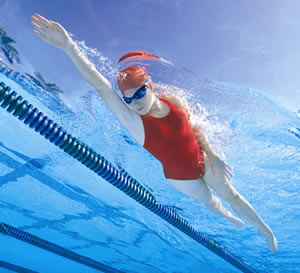Why you should “Separate Water Molecules”

By Terry Laughlin
TI Coach Fiona Laughlin shows drag-minimizing form. Photo courtesy of Total Immersion
You’re at this end of the pool, preparing to swim to that end. How will you get there?
“Silly question,” you say. “I’ll get there by pulling and kicking.” Well, a quick lesson in “fluid mechanics” may have you rethinking your stroke next time you swim.
Popular Mechanics published an article about research done by Defense Department engineers and physicists while designing a swim foil for the Navy Seals. After comparing the swimming efficiency of typical humans with that of fish, these scientists calculated that human swimmers convert only 3 percent of our energy into forward motion. For comparison, dolphins are 80 percent energy efficient.
Whether you want to swim faster or farther, you’re better off focusing on cutting energy cost, than on working harder or longer. If you can improve your energy efficiency from, say, 3 percent to 4 percent, that translates into 33 percent energy gain for you.
Such improvement can often be attained in 10 or 12 hours of focused practice while it might take six months to raise your fitness by a similar amount — and even when you do, well over 90 percent will go to waste.
Water is a wall
The main reason swimming wastes so much energy is that water is 1,000 times denser than air. Drag is considerable even at slow speeds and increases by a factor of four as we swim faster: If you swim 10 percent faster, drag increases by 40 percent.
Drag results mainly from the difference between the shape of a fuselage (bullets. bullet trains, torpedoes and fish) and that of a human body. Anything that moves fast through air or water must be tapered in front and sleek behind. That’s because the pointy tip of a fuselage separates molecules gradually before the thicker part comes through. When that doesn’t happen, the molecules move crazily and drag results.
Because human bodies have little in common with fuselages, our strokes create far more commotion than locomotion. Much of our 97 percent energy loss goes into making waves and stirring up turbulence. To avoid that, think more about separating the water molecules in front of you than on pushing back those behind you as you swim.
School for Spearing
Here are three focal points for swimming farther, faster and easier by spearing through the water like a human fish:
1. Hang your head. Relax your head into the water. Aim your head-spine line forward and keep your head inside the “space” your torso will travel through.
2. Follow the tracks. Visualize parallel tracks forward of each shoulder. Slice your arm down the track — like putting it in a coat sleeve — then line up your body to follow it.
3. Taper your feet. Your feet should travel through the sleeve, too. Think more of streamlining your legs than of churning water. Whenever your feet move outside the space your torso traveled through, they create drag, rather than propulsion.
( Editor’s Note: Log onto the Popular Mechanics swim story at http://www.popularmechanics.com/technology/military_law/4223354.html )
Terry Laughlin set U.S. Masters records for the 1- and 2-mile open-water swims and was the top-ranked 55–59 open-water age-group swimmer by avoiding drag. His DVD Easy Freestyle: 21st Century Techniques for Beginners to Advance Swimmers illustrates how to swim “perpetual motion freestyle.” Information and sample clips at www.totalimmersion.net.



